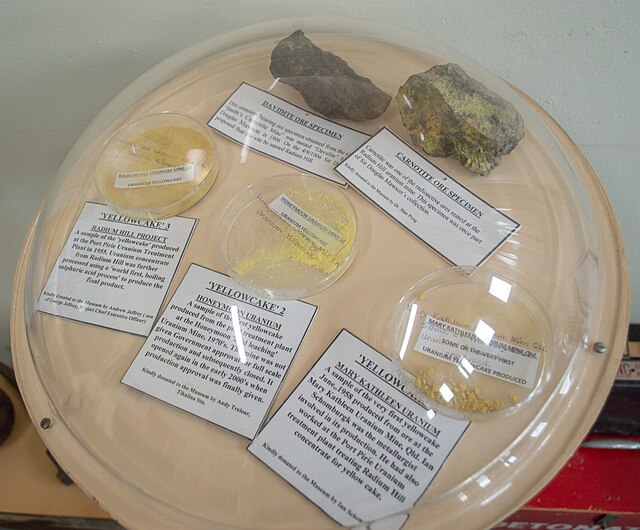Shinkolobwe, or Kasolo, or Chinkolobew, or Shainkolobwe, was a radium and uranium mine in the Haut-Katanga Province of the Democratic Republic of the Congo (DRC), located 20 km (12.4 mi) west of Likasi, 20 km (12.4 mi) south of Kambove, and about 145 km (90.1 mi) northwest of Lubumbashi.
Shinkolobwe mine, 1925
Schoepite-curite-uraninite, huge old specimen. Very heavy, as matrix is pure uraninite (steel-gray). Shinkolobwe is the type locality for schoepite and curite. Ex-Carnegie Museum of Natural History, removed from display for being "too hot"(radioactive). Size: 14.0 x 10.0 x 7.2 cm.
Uranophane in malachite specimen from the Shinkolobwe mine
Uranium mining is the process of extraction of uranium ore from the ground. Over 50 thousand tons of uranium were produced in 2019. Kazakhstan, Canada, and Australia were the top three uranium producers, respectively, and together account for 68% of world production. Other countries producing more than 1,000 tons per year included Namibia, Niger, Russia, Uzbekistan, the United States, and China. Nearly all of the world's mined uranium is used to power nuclear power plants. Historically uranium was also used in applications such as uranium glass or ferrouranium but those applications have declined due to the radioactivity of uranium and are nowadays mostly supplied with a plentiful cheap supply of depleted uranium which is also used in uranium ammunition. In addition to being cheaper, depleted uranium is also less radioactive due to a lower content of short-lived 234U and 235U than natural uranium.
Schematic diagram of stages from uranium mining to energy production
Miners on North Star Mountain in Colorado, 1879
Yellowcake and ore mined in Australia
The Mi Vida uranium mine, near Moab, Utah. Note alternating red and white/green sandstone. This type of uranium deposit is easier and cheaper to mine than the other types because the uranium is found not far from the surface of the crust.







